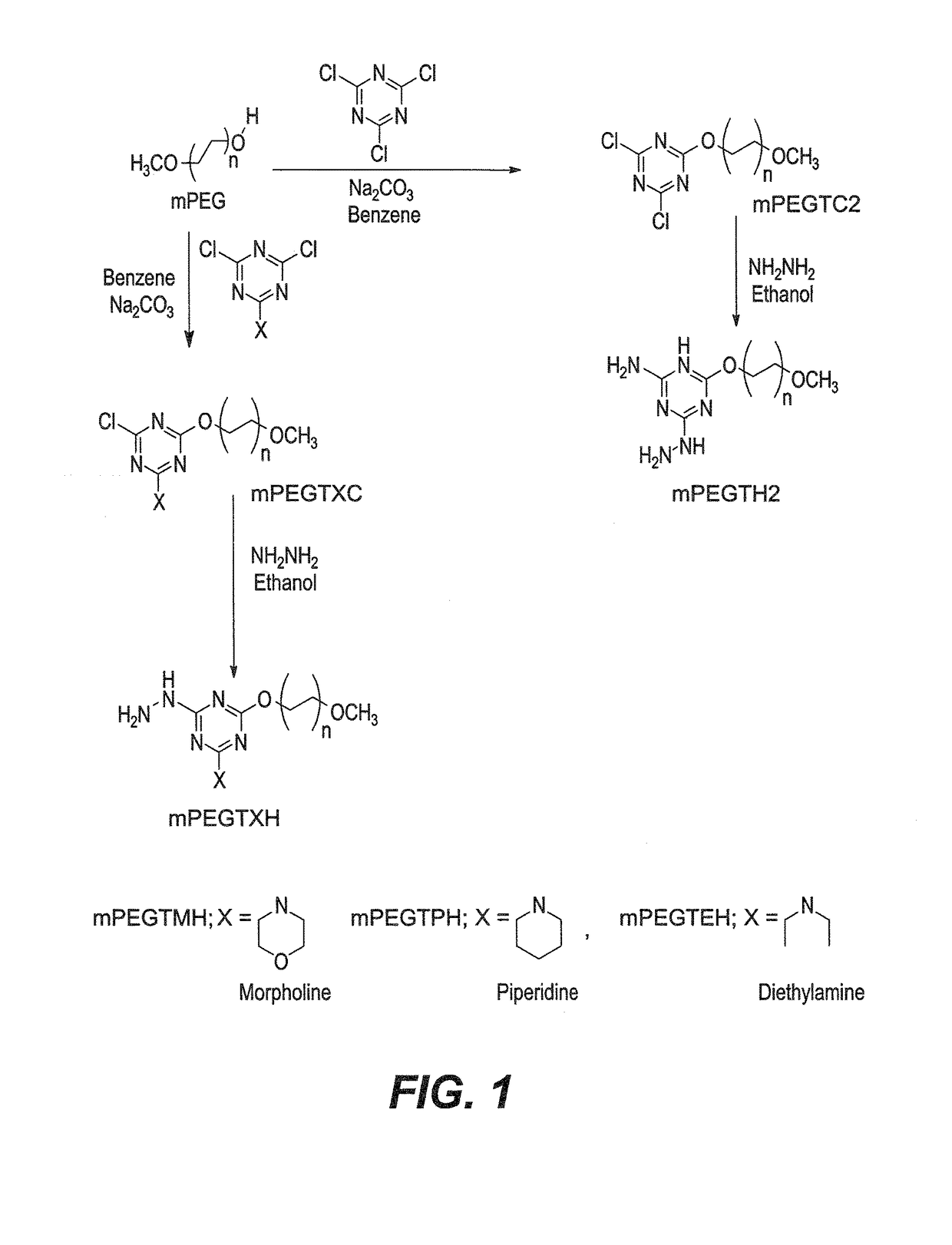Synthesis of metal nanoparticles using modified MPEG polymer
- Summary
- Abstract
- Description
- Claims
- Application Information
AI Technical Summary
Benefits of technology
Problems solved by technology
Method used
Image
Examples
example 1
Synthesis of (mPEGTC2)
[0044]About 20 gm of mPEG (2000 or 5000 molar mass) was dissolved in anhydrous benzene (200 mL), cooled to 15° C., and then slowly added to a solution of cyanuric chloride in benzene (5-fold molar excess, in 200 mL); 5-fold molar excess of anhydrous sodium carbonate was then added. The mixture was stirred for 24 h at 25° C., and then the sodium carbonate was removed by vacuum filtration. The mPEGTC2 derivative was precipitated with petroleum ether 40-60 ratio, the precipitate collected by vacuum filtration, and then re-suspended in benzene (100 mL) and precipitated again with petroleum ether 40-60. This process was repeated one more times to remove any unreacted cyanuric chloride and afford the pure white solid in 82% yield.
example 2
Synthesis of (mPEGTXC)
[0045]About 20 gm of mPEG (2000 or 5000 Molar mass) was dissolved in anhydrous benzene (200 mL), cooled to 15° C., and then slowly added to a solution of 2,4-dichloro-6-substituted-1,3,5-triazine in benzene (5-fold molar excess, in 200 mL); 5-fold molar excess of anhydrous sodium carbonate was then added. The mixture was stirred for 24 h at 60° C., and then the sodium carbonate was removed by vacuum filtration. The mPEGTXC derivative was precipitated with petroleum ether 40-60, the precipitate collected by vacuum filtration, and then resuspended in benzene (100 mL) and precipitated again with petroleum ether 40-60. This process was repeated one more times to remove any unreacted cyanuric chloride and afford the pure white solid in 80% yield.
example 3
Synthesis of mPEGTH2
[0046]10 g of mPEGTC2 were added to a solution of hydrazine hydrate 80% (20 mL) in ethanol (100 mL). The reaction mixture was refluxed for 6 h. The reaction mixture was cooled to room temperature and the excess of solvent and hydrazine hydrate were concentrated under reduced pressure, and then excess ether was added to afford a white solid, which was separated by filtration, washed with ether, and then dried under vacuum to afford the final modified product mPEGTH2 in almost quantitative yield (FIG. 1).
PUM
| Property | Measurement | Unit |
|---|---|---|
| Diameter | aaaaa | aaaaa |
| Diameter | aaaaa | aaaaa |
| Diameter | aaaaa | aaaaa |
Abstract
Description
Claims
Application Information
 Login to view more
Login to view more - R&D Engineer
- R&D Manager
- IP Professional
- Industry Leading Data Capabilities
- Powerful AI technology
- Patent DNA Extraction
Browse by: Latest US Patents, China's latest patents, Technical Efficacy Thesaurus, Application Domain, Technology Topic.
© 2024 PatSnap. All rights reserved.Legal|Privacy policy|Modern Slavery Act Transparency Statement|Sitemap



